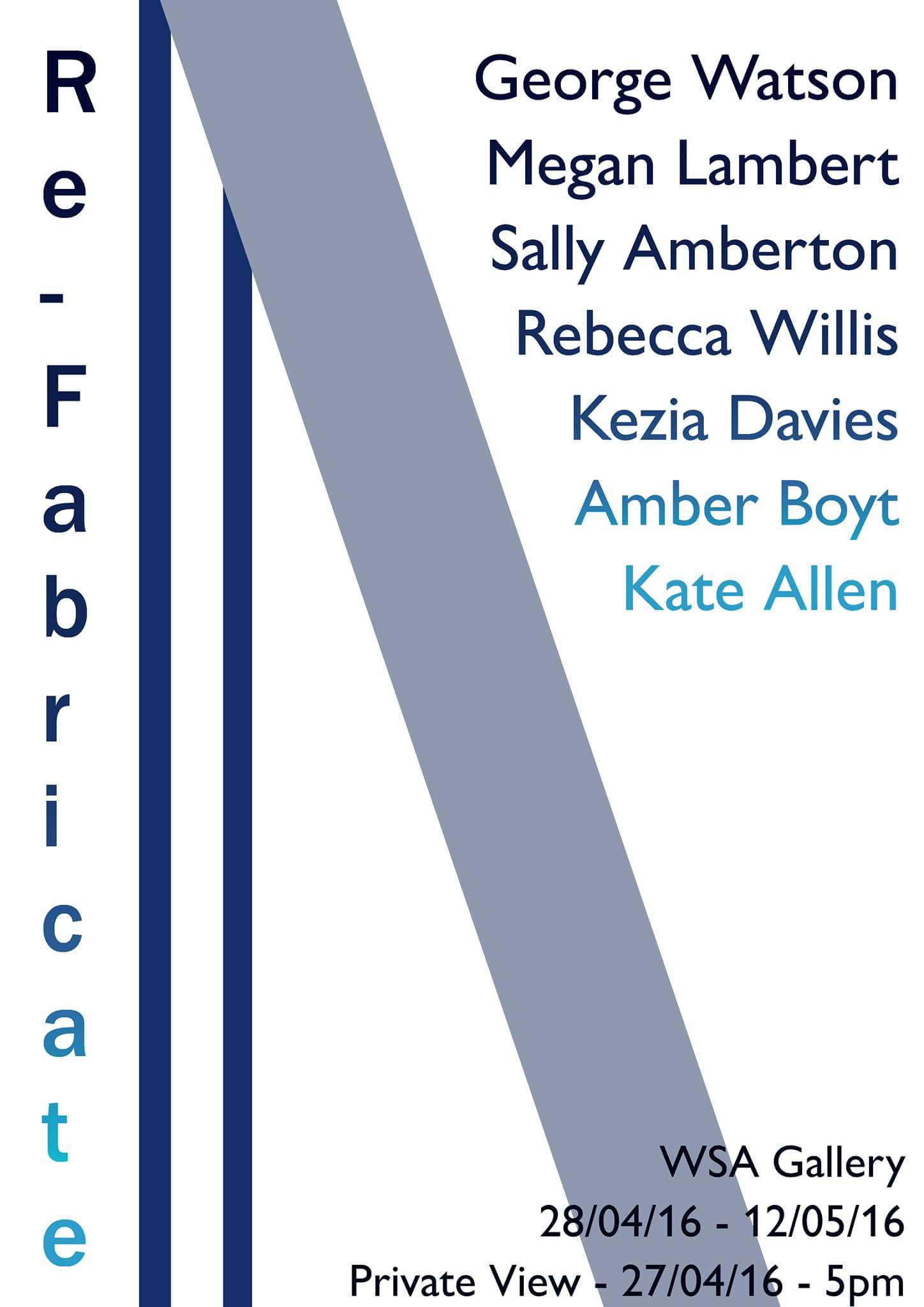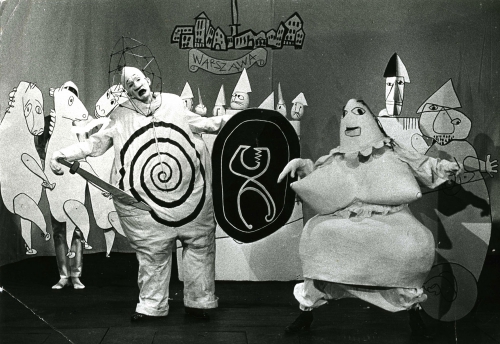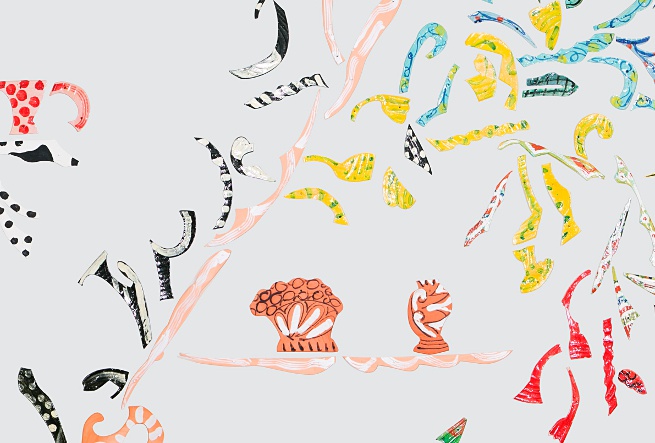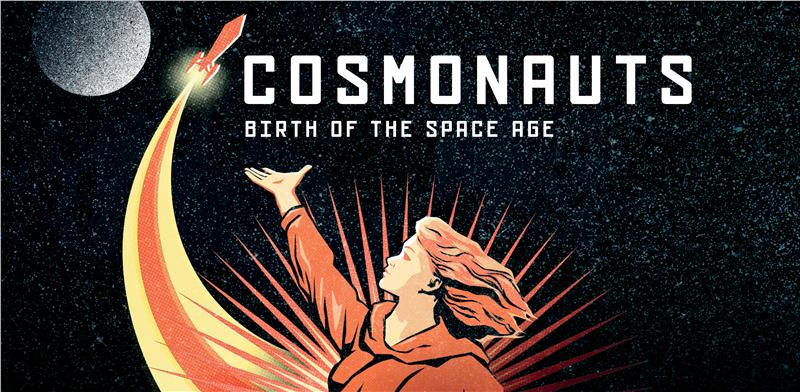This is the last week to catch Refabricate, the current exhibition in the WSA Gallery exploring the relationships between textiles and art and featuring the work of Printed Textile student Sally Amberton. Her involvment in the show came about from conversations at the cross-disciplinary ‘Hookers Knitters and Stitchers’ Society of which Sally is president.
Tag Archives: Exhibition
Franciszka & Stefan Themerson – Books, Camera, Ubu
24 March – 5 June 2016 at Camden Arts Centre
Partners and life-long collaborators from 1929 until their deaths in 1988, Franciszka and Stefan Themersons’ diverse practice encompassed painting, photography, film, theatre design, literature, concrete poetry, publishing and illustration.
Acclaimed as the most important experimental filmmakers in pre-war Poland, they were driven by a dedication to defy convention, avoiding repetition of expression through continual experimentation. Founding the independent publishing house Gaberbocchus Press in 1948, they published more than sixty titles, aimed to be ‘best lookers rather than best sellers’, including works by Raymond Queneau, Bertrand Russell and Kurt Schwitters. Throughout their careers and across all their art forms, they attentively unpacked issues of ethics, language, freedom, conformism, dignity and the human condition.
Books, Camera, Ubu focuses on three main areas of their creative output; their pioneering experimental film practice; the Gaberbocchus Press; and Franciszka’s stage design, puppets and a comic strip, all on the subject of Alfred Jarry’s anarchic 1890s play, Ubu Roi.
Painting the Modern Garden: Monet to Matisse
30 January — 20 April 2016 at The Royal Academy
Using the work of Monet as a starting point, this landmark exhibition examines the role gardens played in the evolution of art from the early 1860s through to the 1920s.
Channa Horwitz at Raven Row
Channa Horwitz (1932–2013, Los Angeles) was amongst the pioneers in the late 1960s and 70s of a distinctly Californian minimalism. She came relatively late to art, arranging it around her home life, and despite corresponding and swapping work with Sol LeWitt, she received little attention from the art world until the end of her life.
Horwitz claimed artistic freedom through confinement to a few simple rules. She came to base all her work on the numbers one to eight – often deploying a colour code for each number – and used this system to depict time and movement. Her outstanding series titled Sonakinatography can be understood in terms of notation, for instance for music or choreography.
Working mostly without the promise of exhibition, Horwitz was disciplined and prolific. Although she experimented with other materials – sculpture and photography, as well as performance and ultimately installation – her preferred form was drawing, often using ink on standard graph paper. At times during the exhibition Horwitz’s work will be activated through music, and dance, and movement workshops.
Hilma af Klint: Painting the Unseen at The Serpentine
3 March – 15 May 2016
Serpentine Galleries presents an exhibition of Swedish painter Hilma af Klint (1862–1944), who is now regarded as a pioneer of abstract art. While her paintings were not seen publicly until 1986, her work from the early 20th century pre-dates the first purely abstract paintings by Wassily Kandinsky, Piet Mondrian and Kazimir Malevich.
This Serpentine exhibition focuses primarily on af Klint’s body of work,The Paintings for the Temple, which dates from 1906–15. The sequential nature of her work is highlighted by the inclusion in the exhibition of numerous paintings from key series, some never-before exhibited in the UK.
To read more go here
Woven Textiles alumni Hannah Auerbach involved in new Tibor Reich Exhibition at the Whitworth
A major retrospective at the Whitworth, Manchester opens 29th January – August 2016 of the pioneering post-war textile designer Tibor Reich, who brought modernity into British textiles.
In 2015 Tibor Reich’s Grandson, Sam Reich, began the huge task of reviving his Grandfathers company, Tibor Ltd. WSA and RCA alumni Hannah Auerbach has been working as head of woven textiles exploring and resurrecting Tibor’s vast archive of designs. You can read more about her experience and process in an interview on The Weave Shed.
The exhibition follows Reich’s complex and multifaceted career as a designer that spanned over four decades. A wide range of his designs, sketchbooks and artworks will be on display.
Images and text copyright: Tibor Ltd.
Betty Woodman: Theatre of the Domestic at the ICA
3 Feb 2016 – 10 Apr 2016
The first UK solo presentation of works by Betty Woodman (born 1930), one of the most important contemporary artists working with ceramics today. The exhibition focuses on work Woodman has created in the last ten years, including a number of major new mixed media pieces.
Betty Woodman began making work in 1950 with clay as her chosen medium, and throughout her practice has constantly explored new directions and introduced new techniques and media. Woodman’s conceptual boldness and her ambitious experimentation—in which she combines such unlikely materials as lacquer paint on earthenware and terra sigillata, a slip glaze often used on ancient ceramics, on paper—have generated a unique series of innovations. Significantly, the ways in which she combines ceramics and painting in her three-dimensional works resonates with younger generations of artists.
All her work relates to her ceramics, their decorative design, imagery and unusual use of various media, and can be seen as a way of exploring her painterly sensibility. For many years she has focused on the vase, which over time has become her most salient subject. For Woodman, the vase can be a vessel, a human body, and animal figure, a metaphor, or an art-historical reference. Painting, particularly in recent years, plays a key role in the work of Betty Woodman. Her later works are large, colourful drawings and paintings on handmade paper or canvas that combine graphite, ink and lacquer with terra sigillata and wax. Her work alludes to and blends numerous sources, including Minoan and Egyptian art, Greek and Etruscan sculpture, Tang Dynasty works, majolica and Sèvres porcelain, Italian Baroque architecture, and the paintings of Bonnard, Picasso and Matisse.
Timorous Beasties Exhibition at Winchester Discovery Centre
World-renowned design company exhibits at Winchester Discovery Centre
This multi-award-winning, internationally acclaimed company are at the forefront of British design, working with clients such as Fortnum & Mason, Famous Grouse, the V&A and Nike.
Mixing design and production under one roof, Timorous Beasties have the freedom to create their own unique style. Most noted for their surreal and provocative textiles and wallpapers, they work in a wide range of disciplines including graphics, furniture, ceramics and glass.
Until 16th March
More details here
Cosmonauts: Birth of the Space Age
SCIENCE MUSEUM EXHIBITION
In 1957 Russia launched the world’s first artificial satellite, Sputnik, into space and just four years later sent the first ever human – Yuri Gagarin. Discover the dramatic story of how Russia turned the dream of space travel into a reality and became the first nation to explore space in this once-in-a-lifetime exhibition.
Cosmonauts: Birth of the Space Age will reveal the most significant collection of Russian spacecraft and artefacts ever to be shown in the UK, including:
- Vostok 6: the capsule flown by Valentina Tereshkova, the first ever woman in space
- Voskhod 1: the capsule used on the first mission to carry more than one crew member
- LK-3 Lunar Lander: a single cosmonaut craft built to compete with Apollo
- a collection of gadgets that cosmonauts – and pioneering space dogs – need to live in space, including a shower, toilet, medical instruments and survival kits for crash landings.
Explore the historical, cultural and spiritual context of Russian space travel, shaped especially by the turbulent early decades of the twentieth century. See poignant testimonies and memorabilia belonging to some of the biggest names in spaceflight and discover the deeply personal stories of the pioneers who kick-started the space age.
More info here
Intellectual Barbarians: The Kibbo Kift Kindred
This archive display at The Whitechapel Gallery features rare woodcarvings, furniture, ceremonial dress designs and photographs of the English organisation The Kibbo Kift Kindred (1920-1932).
Formed by the artist, writer and pacifist John Hargrave after becoming disillusioned with the Boy Scout movement, the Kibbo Kift philosophy was based on a shared appreciation of nature and handicraft, as well as a commitment to world peace. Though small in number, notable members of the group included suffragettes, scientists and the novelist H.G.Wells.
A 1929 exhibition at the Whitechapel Gallery was a way of spreading their ideas, and this display reveals their remarkable aesthetic drawn from ancient Egyptian, Anglo-Saxon, Celtic and Native American crafts, dress and language. Through revealing photographs and footage of the group on parades and camping trips, this display presents not only a forgotten moment in British social movements but a futuristic vision which continues to resonate today.
Image: Kibbo Kift Kindred members at camp, 1928, Courtesy of Judge Smith, Kibbo Kift Foundation, © Kibbo Kift Foundation













